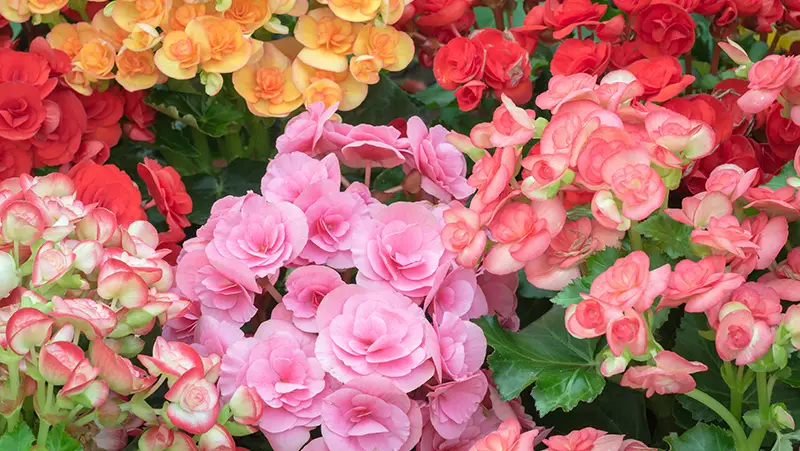Begonias are among the most popular ornamental plants for gardeners who love color, texture, and versatility. Known for their beautiful blooms and striking foliage, begonias can thrive both indoors and outdoors when given the right amount of light. However, one of the most common questions gardeners ask is how much sun begonias actually need. Too much sunlight can scorch their delicate leaves, while too little light can make them leggy and reduce flowering. Understanding their light preferences is essential for keeping begonias lush, healthy, and full of vibrant blooms all season long.
The secret to growing beautiful begonias lies in balancing sunlight exposure with protection from harsh rays. Each begonia variety — whether wax, tuberous, or rex — has slightly different light needs, and knowing these distinctions helps you position your plants perfectly. In this guide, you’ll learn how to identify the right lighting conditions for begonias, recognize signs of too much or too little sun, and adapt your care routine accordingly. With the proper light management, your begonias will reward you with stunning flowers and lush foliage year after year.
Understanding Begonia Light Requirements

Understanding how much sun begonias need starts with recognizing that these plants come from diverse natural habitats. Most begonias originate from tropical and subtropical regions where they grow beneath the forest canopy. This means they’re accustomed to receiving filtered or dappled light rather than direct, intense sunlight. In their native environment, sunlight is softened by overhead foliage, allowing begonias to photosynthesize effectively without leaf damage. When grown in gardens or containers, replicating this balance of light and shade is the key to healthy growth. The challenge lies in providing enough light for strong blooming while preventing sun stress or burn.
Begonias thrive best in bright, indirect light. They need gentle morning sunlight but should be shielded from the harsh afternoon rays, especially during the summer. In cooler climates, they can tolerate more direct sun, while in warmer areas, they benefit from partial shade. Indoor begonias, particularly rex and angel wing varieties, prefer bright filtered light near east- or north-facing windows. Too much shade will make them leggy, with fewer flowers and pale leaves. Too much sunlight, on the other hand, can cause browning and curling at the leaf edges. Striking the right balance between light exposure and protection ensures consistent, lush growth.
It’s also important to consider seasonal changes in light intensity. During spring and early summer, natural light is softer and more ideal for begonias. As sunlight strengthens in mid-summer, providing partial shade or filtered light becomes essential. You can use sheer curtains indoors or shade cloths outdoors to diffuse harsh rays. By mimicking their natural habitat and adjusting lighting conditions throughout the year, you’ll help your begonias thrive in any environment — producing vibrant foliage and abundant blooms that last through the growing season.
Different Begonia Types and Their Sunlight Needs
Wax Begonias (Begonia semperflorens)
Wax begonias are one of the most resilient and adaptable begonia types, favored for their waxy leaves and constant blooms that bring color to gardens and containers. These begonias grow best in bright, indirect light or partial sun, with gentle morning rays being the most beneficial. In cooler climates, they can tolerate four to six hours of direct sunlight daily, but in warmer or drier regions, afternoon shade is essential to prevent scorching. Indoors, wax begonias thrive near an east- or north-facing window where they receive filtered light. Too much direct sunlight can cause leaf burn and discoloration, while insufficient light leads to leggy stems and poor flowering.
To maintain their compact, bushy form, consistent lighting throughout the day is key. Outdoor wax begonias perform well under tree canopies, shaded porches, or next to taller plants that filter sunlight. They flourish in environments that mimic their tropical origins, where light is bright but diffused. For best flowering, keep them in locations that receive dappled sun and stable humidity. When provided with proper lighting and care, wax begonias reward gardeners with a continuous display of blooms and glossy green or bronze foliage from spring until frost, making them one of the most rewarding types for all experience levels.
Tuberous Begonias (Begonia × tuberhybrida)
Tuberous begonias are famous for their spectacular, rose-like flowers in vivid shades of red, pink, yellow, and white. Unlike wax begonias, they prefer cooler temperatures and soft, filtered light. Too much direct sun, especially in the afternoon, can quickly burn their leaves and fade their blossoms. These begonias do best in locations that receive morning sunlight followed by partial shade in the afternoon. Indoors, an east-facing window or a spot with diffused light works perfectly. Maintaining the right balance between sun and shade prevents overheating and ensures continuous flowering.
When grown outdoors, tuberous begonias thrive in hanging baskets, shaded borders, or beneath tall trees that provide protection from harsh sunlight. In hot climates, gardeners often use shade cloth to diffuse bright rays and maintain optimal conditions. Lack of light, however, results in weak stems and fewer blooms. For best results, ensure they get four to five hours of gentle light daily and even moisture in well-draining soil. With consistent lighting and proper airflow, tuberous begonias produce large, showy blooms throughout the season, adding elegance and color to both gardens and patios.
Rex Begonias (Begonia rex-cultorum)
Rex begonias stand out for their breathtaking foliage, featuring a swirl of colors — green, silver, purple, and red — that shimmer when exposed to gentle light. Unlike flowering begonias, rex varieties need very little direct sunlight. They thrive best in bright but filtered light, making them ideal for shaded indoor corners or under fluorescent grow lights. Direct sun can scorch or bleach their ornamental leaves, leaving pale spots and damaged edges. Instead, placing them near north- or east-facing windows provides the perfect lighting balance for strong growth and vibrant leaf color.
Outdoors, rex begonias perform beautifully in full shade or areas that receive only dappled morning sunlight. They prefer humid conditions and consistent moisture in the soil but must be protected from both drought and strong light. If they don’t receive enough light, their colors fade, and the leaves become dull and flat. When given ideal lighting, rex begonias develop lush, velvety leaves with rich contrast and striking patterns. With proper care and placement, they bring dramatic texture and color to indoor displays or shaded garden spaces, making them one of the most eye-catching begonia varieties.
Recognizing Signs of Too Much or Too Little Sun
Recognizing how your begonias respond to sunlight is essential for maintaining healthy growth and vibrant foliage. When begonias receive too much direct sun, especially during hot afternoons, their leaves begin to show signs of stress. You may notice brown or crispy edges, faded patches, or small burn spots on the leaf surface. In severe cases, entire leaves may curl or wilt even when the soil is adequately moist. Flowers can also fade prematurely under intense sunlight, losing their rich color and delicate texture. These symptoms indicate sunburn, a common issue in outdoor begonias exposed to full sun for long hours. To remedy this, move your plants to a shadier location or provide filtered protection using sheer fabric or shade cloth. Indoors, simply reposition the pots away from direct window light to reduce leaf damage.
On the other hand, too little sunlight can make begonias appear weak and leggy. Their stems stretch unnaturally toward the nearest light source, creating thin and unstable growth. Leaves often turn pale green or yellow, and flowering becomes infrequent or stops altogether. Over time, poor lighting also affects the plant’s overall vigor, making it more prone to fungal diseases due to excess moisture retention. To correct this, gradually introduce your begonias to brighter light, starting with gentle morning sun. Adjust the placement of indoor plants closer to windows that receive filtered daylight. With consistent exposure to the right intensity and duration of light, your begonias will regain their compact shape, deep color, and steady blooming rhythm.
Monitoring how your begonias react to sunlight throughout the day helps you fine-tune their growing environment. Light levels change seasonally, so a location that’s perfect in spring may become too bright in midsummer. Observing leaf color, texture, and posture gives clear clues about their comfort. When you learn to recognize these visual signals, you can quickly adjust your care routine and create ideal lighting conditions year-round. Healthy begonias with balanced light exposure produce lush foliage, strong stems, and continuous blooms — the hallmark of a thriving, well-cared-for plant.
Indoor vs Outdoor Begonias: Managing Sunlight Effectively
Indoor Begonias and Light Management
Growing begonias indoors offers excellent control over light exposure, making it easier to prevent common problems like leaf scorch or leggy growth. Indoor begonias, particularly rex and angel wing varieties, thrive in bright but filtered light. Placing them near east- or north-facing windows provides just the right amount of illumination without exposing them to harsh afternoon sun. If natural light is limited, fluorescent or LED grow lights can supplement their needs for 12 to 14 hours daily. The goal is to create consistent brightness that mimics dappled sunlight from a forest canopy. Too little light results in pale, stretched stems, while too much direct exposure causes leaf discoloration and dry edges.
To maintain even light distribution, rotate your begonias every few days so all sides receive equal illumination. Avoid placing them directly against cold window panes or in spots where heat builds up from the sun. Using sheer curtains is an effective way to diffuse strong light while maintaining visibility and warmth. Keep an eye on the leaves — healthy indoor begonias will display rich color and sturdy growth. When managed properly, indoor lighting allows begonias to flourish year-round, maintaining their decorative charm and producing consistent blooms in bright, comfortable conditions.
Outdoor Begonias and Sunlight Control
Outdoor begonias benefit from natural sunlight but require thoughtful placement to avoid overheating or wilting. Most begonias do best in partial shade, where they receive gentle morning sun and filtered afternoon light. Placing them under trees, on shaded patios, or near taller plants helps recreate their native understory environment. In cooler regions, outdoor begonias can tolerate several hours of direct sun, but in hot climates, they must be shielded during midday. Too much sun exposure outdoors can lead to leaf curling, browning, and reduced flowering.
If your garden experiences intense summer light, use shade cloths or hanging baskets positioned under pergolas to protect the plants. Keeping the soil consistently moist also helps prevent sun stress. Avoid relocating begonias abruptly between full sun and shade, as sudden changes can shock the plants. Gradual adjustments give them time to adapt to new light levels. Observing how your begonias react to outdoor light over time helps you find their perfect spot. With balanced exposure and steady care, outdoor begonias reward you with dense foliage and brilliant, long-lasting blooms throughout the season.
Best Locations for Growing Begonias Based on Light Conditions
Choosing the right location for your begonias is the foundation for vibrant growth and abundant flowering. Because begonias are sensitive to extreme light exposure, their placement can make the difference between thriving plants and struggling ones. For outdoor settings, areas that receive gentle morning sunlight followed by afternoon shade are ideal. This provides enough brightness for photosynthesis without overwhelming the delicate foliage. East-facing garden beds, shaded patios, and spots beneath trees or pergolas are perfect for maintaining this balance. If you live in a cooler region, begonias can tolerate more direct sunlight, while those in warmer climates should be placed where midday light is filtered. Always monitor your plants during seasonal changes — light intensity increases significantly during summer, which may require added shade or repositioning.
For indoor begonias, placement near a window that provides bright but diffused light works best. East- and north-facing windows are generally ideal since they offer soft, natural brightness without harsh rays. If your home receives limited sunlight, supplementing with grow lights ensures healthy development. Keep plants a few feet from the window to avoid overheating and rotate them regularly for even light distribution. Avoid dark corners or windowless rooms, as begonias in low light will quickly lose color and vigor. Maintaining stable lighting indoors replicates their natural forest environment, encouraging compact growth and vibrant leaves.
Hanging baskets and container arrangements also benefit from strategic positioning. Hanging begonias, in particular, enjoy spots with filtered sunlight and good air circulation. Porch railings, balcony edges, or shaded patio corners often provide ideal conditions. By carefully selecting and adjusting the placement of your begonias, you ensure they receive consistent light suited to their needs. The right location not only enhances their appearance but also extends the blooming season, keeping your begonias radiant and full of life from spring through fall.
How to Adjust Begonia Light Exposure Throughout the Year
Light conditions change with the seasons, and begonias respond noticeably to these shifts. To keep your plants healthy year-round, it’s important to adjust their exposure as sunlight intensity and duration vary. In spring, light is gentle and ideal for growth. This is the best time to let begonias enjoy more direct sunlight, especially in the mornings. The moderate warmth and soft rays help stimulate new leaf and flower production. As daylight hours increase, gradually introduce more exposure to natural light to strengthen the plants. This seasonal transition period is also perfect for repotting or moving begonias outdoors after winter dormancy, ensuring they adapt smoothly to brighter environments.
By summer, sunlight becomes more intense, and begonias require extra protection. The afternoon sun can be harsh, particularly in warmer climates, leading to leaf scorching and dehydration. Moving begonias to partially shaded spots or providing filtered protection through shade cloths helps maintain ideal conditions. Indoors, you can reposition pots farther from windows or use sheer curtains to diffuse direct rays. Regular observation is crucial — if leaves start curling, browning, or fading, it’s a sign your plants are receiving too much sun. At this stage, balance is key: ensure they still get enough light to bloom without suffering heat stress. Consistent watering and humidity also help counteract strong light exposure.
As autumn and winter arrive, sunlight weakens, and days become shorter. During these cooler months, begonias benefit from increased light access. Move them closer to windows where they can absorb more daylight or use grow lights to supplement natural light. Indoor begonias, especially rex varieties, need at least 12 hours of bright, indirect illumination to maintain their leaf color. Outdoor begonias should be brought indoors before frost sets in. Adjusting their light exposure according to seasonal cycles not only prevents stress but also extends their lifespan. By aligning your care routine with nature’s rhythm, your begonias will remain vibrant, strong, and continuously rewarding no matter the time of year.
Common Lighting Mistakes Gardeners Make with Begonias
Exposing Begonias to Too Much Direct Sun
One of the most common lighting mistakes gardeners make is giving begonias too much direct sunlight. Although begonias enjoy bright environments, their delicate leaves cannot tolerate prolonged exposure to harsh rays, especially during midday. Excessive sunlight causes leaf scorch, browning edges, and faded colors. In severe cases, it can also dehydrate the plant, leaving it weak and stunted. Gardeners in hot regions often make this mistake by placing begonias in full-sun garden beds without shade protection. The damage may appear quickly in summer, with the leaves curling or developing dry patches even when watered properly.
To prevent this, always provide partial shade during the hottest hours of the day. Outdoor begonias should receive morning sun and afternoon shade, while indoor plants should be kept behind sheer curtains or slightly away from windows. Consistent observation helps detect early signs of sun stress. Adjusting light exposure promptly can restore the plant’s health and prevent permanent damage. Understanding that begonias thrive under filtered, indirect light ensures steady growth and abundant blooms rather than scorched foliage.
Keeping Begonias in Too Much Shade
Another common mistake is placing begonias in locations that are too shaded. While these plants dislike intense sun, they still need adequate brightness for proper photosynthesis. Too little light causes the stems to elongate unnaturally as the plant stretches toward the nearest light source, resulting in weak, floppy growth. The leaves may become dull or pale, and flowering slows dramatically. In some cases, begonias stop blooming altogether, focusing only on stem and leaf survival. Many gardeners misinterpret this as a watering or nutrient problem when, in fact, the issue is insufficient light.
To fix this, gradually move begonias to brighter spots with indirect sunlight. Indoors, position them closer to east- or north-facing windows, or use artificial grow lights to supplement. Outdoors, relocate them to partially shaded areas where they can receive gentle morning sunlight. Once the light improves, begonias typically regain color, strength, and flowering vigor. Balancing brightness and protection helps maintain compact growth and vibrant foliage, preventing the legginess that often develops from too much shade.
Failing to Adjust Lighting with the Seasons
Begonias’ lighting needs change throughout the year, yet many gardeners forget to adjust their plant’s position as sunlight intensity shifts. During spring and early summer, the light is perfect for promoting new growth, but as temperatures rise, the sun becomes too strong, demanding shade protection. Conversely, in autumn and winter, weaker sunlight can cause begonias to languish if they’re kept in the same shaded location. Without adjustment, plants either burn in summer or fade during the colder months.
To avoid this mistake, adapt lighting based on seasonal conditions. Move outdoor begonias under shade structures in midsummer, and reposition them closer to bright windows or under grow lights in winter. Monitoring the sun’s path helps maintain consistent brightness levels year-round. By adjusting exposure seasonally, gardeners can keep begonias vigorous, colorful, and well-balanced through all weather changes — ensuring they continue blooming beautifully no matter the season.
How to Combine Light, Temperature, and Humidity for Strong Begonia Growth
Light, temperature, and humidity work together to create the perfect environment for healthy begonia growth. Even with the right lighting, begonias can struggle if temperature or humidity levels are unbalanced. Ideally, begonias thrive in temperatures between 65°F and 75°F (18°C–24°C), with a consistent level of warmth throughout the day. Sudden temperature drops or drafts can stress the plant, causing leaf drop and slower growth. When temperatures are too high, begonias lose moisture faster and become more prone to sunburn, especially in bright light. To maintain balance, position them in spots that stay warm but not hot, avoiding direct exposure to heat sources like radiators or unfiltered afternoon sun. Stable warmth supports steady photosynthesis and prevents shock when light conditions shift seasonally.
Humidity plays an equally vital role in complementing proper light exposure. Begonias prefer moderate to high humidity — around 50% to 60% — to maintain vibrant, supple leaves. In dry environments or during winter when indoor heating lowers humidity, leaves may curl or develop crispy edges. To counteract this, place a humidity tray filled with water and pebbles near your plants or use a humidifier to maintain moisture levels in the air. Misting the surrounding area occasionally can also help, but avoid spraying directly on leaves, as lingering water can lead to fungal issues. For outdoor begonias, natural humidity is usually sufficient, though in hot, dry climates, shaded areas with consistent moisture work best.
Balancing these three factors ensures begonias grow strong, resilient, and vibrant. Light drives energy production, temperature regulates growth rate, and humidity keeps the foliage healthy and hydrated. When these conditions align, begonias flourish with deep-colored leaves, consistent blooms, and sturdy stems. Observing your plants and fine-tuning their environment based on the season will keep them thriving year-round. With careful attention to these interconnected needs, your begonias will reward you with lush foliage and long-lasting flowers that brighten every corner of your home or garden.
FAQs About Begonia Light Requirements
How many hours of sunlight do begonias need each day?
Most begonias thrive with about four to six hours of bright, indirect sunlight daily. Morning sunlight is best, as it’s gentle and helps fuel growth without causing leaf burn. In shaded gardens or indoor settings, supplement with artificial grow lights to maintain consistent brightness and prevent legginess.
Can begonias grow in full sun?
Begonias can tolerate full sun only under mild conditions, such as in cooler climates or during early spring. However, in hot or dry regions, full sunlight can quickly scorch their leaves. It’s best to give them morning sun and afternoon shade or place them where light is filtered through trees or sheer curtains.
Will begonias grow in full shade?
Begonias can survive in full shade but won’t perform at their best. Too little light leads to weak stems, pale foliage, and fewer blooms. For lush, colorful plants, aim for partial shade — bright but indirect light that mimics their native forest conditions. This balance encourages healthy flowering and compact growth.
How can I tell if my begonias are getting too much sun?
If your begonias have brown, crispy leaf edges, faded patches, or curled leaves, they’re receiving too much direct sunlight. The flowers may also wilt quickly. Move them to a shadier location or provide filtered protection using sheer fabric or a light shade cloth to prevent further damage.
What’s the best window direction for indoor begonias?
East-facing windows are ideal for begonias because they provide bright, gentle morning sunlight without the intensity of afternoon rays. North-facing windows also work well in warmer climates. Avoid west- or south-facing windows unless you diffuse the light with curtains to protect delicate leaves from excessive heat.
Conclusion
Understanding how much sun begonias need is the foundation of keeping these vibrant plants healthy and beautiful. By giving them bright, indirect light, protecting them from harsh rays, and adjusting exposure with the seasons, you create the ideal growing conditions. Whether indoors or outdoors, balancing sunlight with proper temperature and humidity ensures begonias flourish year-round. Each variety has its own preferences, but all thrive when light is consistent, gentle, and carefully managed. With thoughtful placement and regular observation, your begonias will reward you with lush foliage, vivid blooms, and lasting color season after season.






